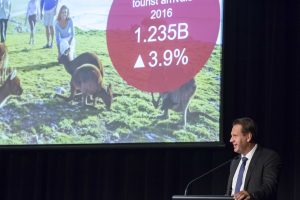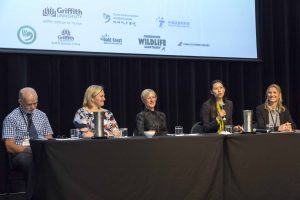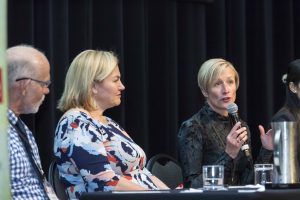This dialogue celebrated the China-Australia Year of Tourism and also the UN Year of Sustainable Tourism for Development. Therefore it was appropriate to focus on the topic of ‘managing tourism growth sustainably’. The event was co-hosted by the Griffith Institute for Tourism and the Griffith Confucius Institute.
The conference was well attended with over 120 delegates, mainly from Australia and China, but also six other countries who offered complementary insights and perspectives. Following the Griffith Innovation Showcase on the first day, where we demonstrated new research methods and approaches, it was great to welcome so many friends, colleagues and guests for drinks by the pool. The second day was opened by Prof Ian O’Connor, Vice Chancellor of Griffith University, Bob East, Chair of Tourism Australia and CEO of the Mantra Group, and Prof Bin Dai, President of the China Tourism Academy. What followed was a series of extraordinary presentations by 26 industry speakers and panelists.
What did we learn?
First, there is simply no way around the need to better understand China as a key player (or rather, the player) in the global tourism market. This became clear not only in some of the statistics that speakers shared (e.g. a middle class of over 800 million by 2030!; 200 new airports being built in China), but also in the sophistication with which Chinese companies, such as Alipay and C-trip, have conquered the markets. Not engaging with these trends, the digital platforms and big data analytics that come with them, is not an option.
We also learned about the customer experience and the increasing need to tailor experiences right from the start to the end of a trip. Concepts such as attention seeking and seizing were shared and examples of leading practice in tourism discussed. A fascinating example that really raises the bar for other players in the industry is Dubai International Airport, where traditional border controls are replaced with a walk through a virtual aquarium tunnel. The new system is not only faster with greater accuracy rates, but also offers a great visitor experience. It became clear that in this fast moving world of technology, it is critical for countries such as Australia to remain competitive and attractive for the higher yielding markets.
Investments and sustainability were discussed, but are not always linked. Investments often happen in gateway cities (including integrated resorts) and transportation routes, and whilst sustainability is increasingly considered, it does not yet appear to be integral. Instead, sustainability projects are often implemented at a smaller scale with a people-focused approach. The presentations on My Green Butler, a smart service system to reduce guests’ resource consumption in tourist accommodation, and managing resources through the National Trust, were highly complementary. Creating new and sustainable experiences should, in theory, align well with the experience economy, but the link is not explicitly made in practice or on a large scale (yet).
Growth, investment and design of new experiences has to address issues of over-tourism and crowding. It become clear that some parts of Australia lack the wider infrastructure to cope with tourism demand, and at the same time also lack investment in regions to help spread visitors away from major centres. Whilst some solutions were discussed (e.g. the youth market spreading further into regions), it appears that it is difficult to lure people away from the iconic attractions such as the Sydney Opera House. Possibly, direct marketing (e.g. using big data and customised approaches) might provide an opportunity – if there is a genuine interest in doing so. The New Zealand story highlighted the risks of too much visitor pressure on communities and natural assets and it was made very clear that a coherent tourism strategy to cope with growth is much needed.
Tourism is not isolated from the broader bi- and multi-lateral relationships between countries, and both policies and politics that go with them. Discussing wider issues such as border arrangements (e.g. one custom zone for Australia and New Zealand and possibly key ports in China), foreign investment by Chinese companies, airline networks, and foreign policy, it become – once again – clear that the relationship between Australia and China is of great importance (at least to the Australian economy). Institutional partnerships, such as the one between the China Tourism Academy and Tourism Research Australia, that facilitate the exchange of information, knowledge and data are integral to successfully managing tourism flows.
The third day continued the information sharing and discussions in the form of academic presentations. Many papers provided interesting detail on very specific issues that further explored some of the macro challenges discussed the day before. For example, it was asked what an ‘ideal tourist’ is and how this could be measured to ensure that destinations secure long-term benefits along several dimensions. A new theme emerged from the presentations: food. The importance of food and cuisine was emphasised and analysed in several papers, and followed on well from the points made earlier on personalised customer experiences.
The final wrap up reminded us of the need to link practical and academic work better so that theoretical research becomes more relevant to decision makers. Avoiding the pitfalls of sustained – yet unsustainable – growth will require critical thinkers to examine opportunities and risks and provide robust knowledge that is relevant to the problems of the industry.
We thank everyone for their great contribution and hope you enjoyed the event as much as we did.
Prof Susanne Becken




